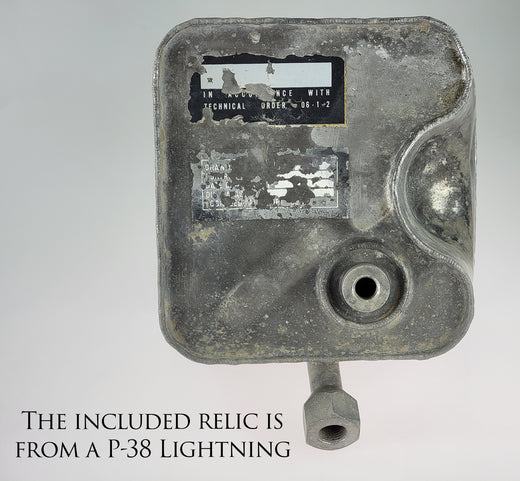This art piece captures two pivotal moments in World War II aviation history: the ambush of Admiral Isoroku Yamamoto's Betty bombers by P-38G Lightnings, led by Lt. Rex Barber on 18 April 1943, and the enduring legacy of the P-38 Lightning, with relics recovered decades later, symbolizing the resilience and valor of the men and aircraft that shaped these events.
Details about the RELIC:
This original 1940s oil tank, once a vital component of the legendary Lockheed P-38 Lightning, was recovered in 2020 from an aircraft hangar in Los Angeles, California. Alongside other surplus and unrestorable parts, this tank serves as a tangible reminder of the aircraft’s historical significance. The P-38 was a crucial element of the Allied air forces during World War II, renowned for its speed, versatility, and long-range capabilities. As a multi-role fighter, the P-38 was involved in dogfights, bombing missions, and reconnaissance efforts throughout the war.
 P-38 Lightning relic included in the "Operation Vengeance" limited edition print
P-38 Lightning relic included in the "Operation Vengeance" limited edition print
Although unrestored, these components retain the essence of the countless missions flown and the dedicated men who serviced and flew them. Each piece, even after decades of dormancy, speaks to the resilience and ingenuity of the wartime efforts.
 Relic fragment included with each canvas art piece
Relic fragment included with each canvas art piece
The Story Behind the Print:
On 18 April 1943, after flying over 400 miles of open ocean, obscured by the early morning mist, a squadron of P-38G Lightnings from the 339th Fighter Squadron reached a designated intercept point over Bougainville Island. Their mission was to ambush a flight of Japanese Betty bombers. Leading the group was Lt. Rex Barber, piloting his P-38G "Miss Virginia." Their target was no ordinary formation—one of the bombers was transporting Admiral Isoroku Yamamoto, the mastermind behind Japan’s attack on Pearl Harbor.
The P-38s, utilizing their long-range capabilities, approached undetected. Lt. Barber engaged the Betty bombers, and both aircraft were successfully shot down, killing Yamamoto and key members of his staff. The mission, codenamed "Operation Vengeance," left Japan reeling from the loss of its most skilled naval strategist. Yamamoto’s death dealt a heavy blow to Japanese morale and significantly altered the course of the Pacific War.
Learn more about Why the Germans Feared the P-38 in Fork-Tailed Devil? Click Here
To purchase or see similar items, visit here.
Commissioned by Museums, Treasured by Collectors





Share:
Stuka Aluminum JU-87 B1 W. Nr. 5611
Victory in the Skies, the story behind "The Prowl of Jutta"